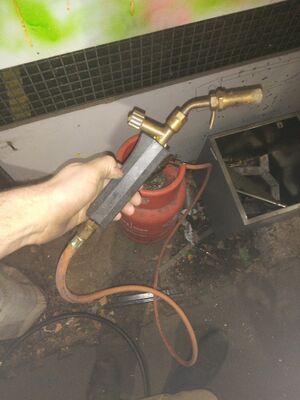Propane Torch (Sievert)
(Redirected from Torch, Propane (Sievert))
A light-duty torch intended primarily for soldering or light brazing, but it can also be used for other heating tasks such as heat-treating or hot bending. For heating larger parts the heavy-duty Flamefast torch might be a better match.
For propane bottles see Gas Storage
Instructions for use:
1) Switch on the gas supply at the bottle
2) Have a lighter to hand. One can usually be found in the metal casting supplies box under the kilns
3) Open the gas valve on the torch lightly. The torch lights best with a small supply of gas
4) Carefully move the lighter into the path of the torch and ignite
5) Adjust the valve on the torch to optimise the gas flow for a steady flame, appropriate in size to the part you are working on. Note too high a gas pressure will blow out the flame, there is a fine balancing act.
6) When finished, switch of the gas AT BOTH THE TORCH AND GAS BOTTLE then return everything where you found it.
Risk Assessment - Gas Torches
This risk assessment is intended to provide guidance on the risk associated with the above equipment and activities in normal use. Please also check general risk assessments for the space as a whole. Any discrepancies, errors or concerns should be raised with the document maintainers or trustees - do not edit this assessment directly. For responsible persons and last update, see 'version log' of the assessment page.
Activity
Heating of metals for hot forming, brazing, soldering or similar purposes, using a handheld or stationary torch that uses Propane or Butane fuels
Signage
Understanding Risk Rating
LOW - Ensure current control measures are in place and continue with activity
MED - Control measures may be adequate, co-supervision is recommended
HIGH - Do not undertake activity without further consultation with area specialists
Risk Assessment
| Identify Hazards | Who May be Harmed and How | Severity | Control Measures | Likelihood | Risk Rating |
|---|---|---|---|---|---|
| Burns from heat. | Users | High | Operators are competent in the use of the equipment. Fire retardant gloves are to be worn. Hot material is to be treated with care and watched until sufficiently cool as not to pose a fire risk. If the equipment is not in satisfactory working order it should not be used. | Medium | Medium |
| Slips Trips and Falls | Users, Bystanders | Medium | Wear shoes or boots with non-slip soles, in particular in wet or snowy weather – make sure excessive wet isn’t tracked into the space. Ensure that good standards of housekeeping are maintained at all times, cables and other equipment will be managed so as not to cause a trip hazard. | Medium | Low |
| Fire from Hot Work | Users, bystanders, public | High | It should be ensured that there is no combustible material in close proximity to the work. Suitable protection should be provided for any combustible items that cannot be moved and for combustible construction such as wooden worktops. A check should be carried out on all of the surrounding areas to minimise the possibility of ignition by heat transfer. Fire extinguishers are be provided in the space. Hot work should be stopped at the specified time before leaving the space. A thorough inspection of the area should be undertaken once the work is complete after completion. Where necessary, a further check should be carried out before leaving the space. | Medium | Medium |
| Use of gas bottles, leaks and high pressure discharge. | Users, bystanders, public | High | Bottles must be secured in the upright position, preferably on a trolley to aid mobility. All gauges, hoses, bagging and torches must be examined before use, any faulty equipment must be repaired or replaced prior to use. | Medium | Low |
